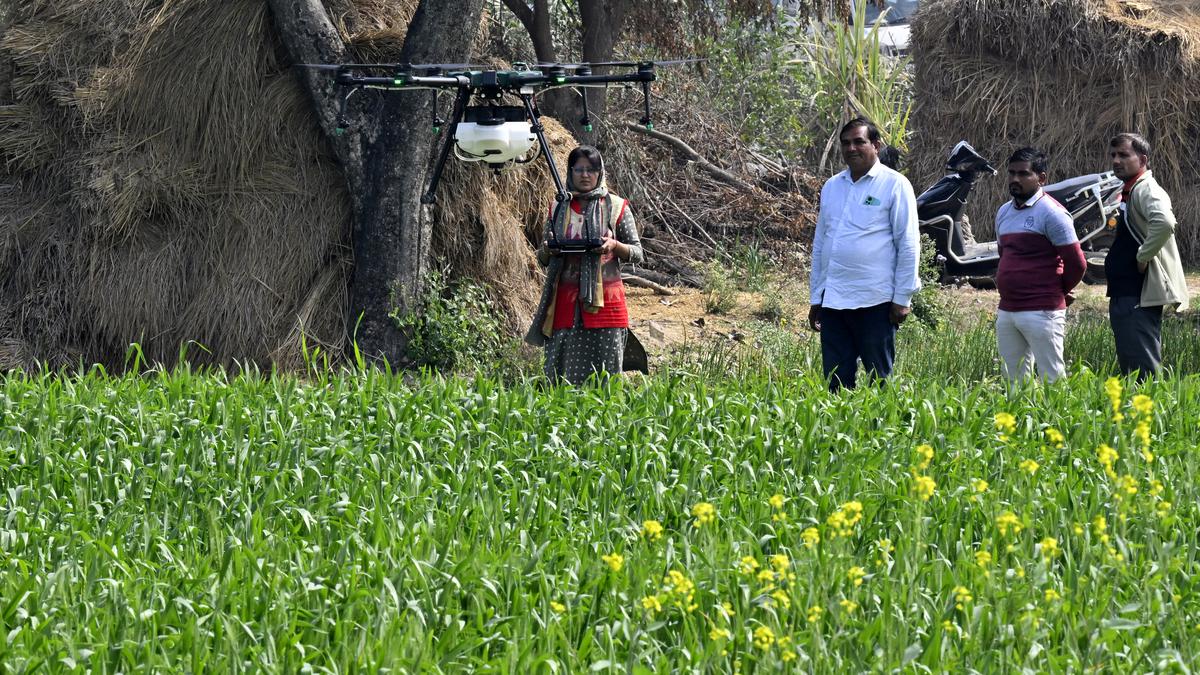
The long, bumpy road from ‘drone didis’ to ‘lakhpati didis’ Premium
The Hindu
Namo Drone Didi scheme trains women to fly drones for agricultural spraying, facing challenges due to protests and internet shutdowns.
A month before farmers began their protest along the Punjab-Haryana border, with the police dropping tear gas shells from drone-based launchers, Ram Raji, 36, had been issued a drone and an electric autorickshaw by a fertilizer company. Raji and several women like her were to spray liquid pesticide over the ripening wheat crop. But when the protests broke out, the drone operator from Qila Zafargarh village in Haryana’s Jind district was disappointed.
“There was a 12-day Internet shutdown in the districts bordering Punjab and Haryana, including Jind. While working in the fields, I need an Internet connection for the GPS signal connecting to the drone,” she explains, standing in front of a field of wheat, and locking an acre to be sprayed on her remote control. February is a crucial month for spraying nano urea over the wheat crop, right before it flowers, and now, farmers feel it’s too late, Raji says. Each workday lost also means a loss of income.
Raji is one of the initial 1,000 drone didis selected by fertilizer companies from across India to be trained under the Central government’s Namo Drone Didi scheme to fly agricultural drones that will spray fertilizers over crops. Armed with a pilot’s licence from the Directorate General of Civil Aviation (DGCA), they are meant to be seen as changemakers.
In November last year, Prime Minister Narendra Modi announced the decision to engage 15,000 women from rural self-help groups (SHGs), at an approved outlay of ₹1,261 crore, to cover the cost of drones and battery sets. This amount has not yet been spent, says a Central government official working closely with the scheme.
Over two months after the announcement, Mr. Modi is slated to interact with the first 1,000 drone didis on March 11. However, officials say exact modalities and the future road map are still unclear. “The government has planned for another 6,000 drone didis to be trained in 2024-25, and another 8,000 in 2025-26,” the official says.
The official adds that the cost of training the first batch of drone didis, equipping them with the drone and its components (four battery sets, a generator), and an electric autorickshaw is being borne by fertilizer companies like Indian Farmers Fertiliser Cooperative Limited (IFFCO) and Coromandel International Limited (CIL).
“IFFCO is supporting training and supply of equipment worth ₹42 crore at the rate of ₹14 lakh per woman, including the electric autorickshaw for 300 drone didis, while CIL is supporting another 200,” the official adds. IFFCO has cited this expense as “benefits to farmers” in its books.

One dies, eight hospitalised after inhaling HCL fumes at pharma company in Andhra Pradesh’s Anakapalli district. About 400 litres of HCL leaked from the reactor-cum-receiver tank at Unit-III of the company, which affected nine workers, says Collector. While the condition of six of them is stable, two are on ventilator support. Chief Minister Chandrababu Naidu directs authorities to provide advanced treatment to the victims. Home Minister Anitha expresses anger over repeated such incidents.










